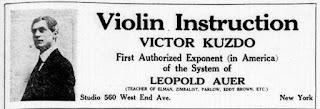In the early decades following the Revolution the Bowery saw
the rise of brick-faced Federal style homes.
While many were upscale residences, the house at No. 206 Bowery was
constructed with a shop on the first floor and residential space above for its
merchant family. Completed around
1810 the two-and-one-half story building included the expected elements of the
Federal style—Flemish bond brickwork and a peaked roof with high dormers.
William Messerve was one of the earliest owners of the
house. He found himself in trouble in
April 1824 when the City Inspector presented the Common Council with an “Ordinance
of Correction” of a nuisance. That
nuisance on Messerve’s property was listed simply as “a privy.”
Shortly thereafter Messerve was gone and Walter and Sarah
Smith Keeler lived at No. 206 Bowery. On
August 9, 1828 their first child, William Ervin Keeler, was born in the
house. Two years later his sister,
Cornelia, arrived.
Walter Keeler operated his shoe store at ground level for
years. By 1837 he seems to have shared
the space with another shoe dealer, Smith & Thomas. That year Charles M. Thomas signed a
petition, along with many other businessmen along the Bowery and nearby
streets, to protest the proposed extension of Centre Street which would result
in the “destroying, mutilating, and injuring every street, lot and building in
its course.”
The drafters of the petition used to the Great Fire of 1835
which had destroyed 17 blocks and caused $20 million in property damage to help
make its point. “The severe and awful
calamity which befell this city two years ago, it is well known to your
honorable body, reduced many from a state of affluence to beggary.” The businessmen argued that taxing these bankrupt
property owners for “public improvements” would be cruel and they deemed the
proposal “a project fraught with evil.”
In 1840 John Cooper replaced the Keeler family at No.
206. His family would live upstairs for
more than a decade while he operated his “fancystore” below. Feminine shoppers dropped in to purchase a
variety of items, from sewing needs to gloves and hosiery. Like Keeler, he shared the ground floor with
another business and in 1841 Andrew Oakley listed his dentist office here.
 |
| Cooper advertised in A. E. Wright's Commercial Directory in 1840 (copyright expired) |
 |
| The Southern Quarterly Review, 1854 (copyright expired) |
The Bowery neighborhood was still respectable in the decade
following the Civil War, despite the influx of immigrants into the area. In the 1870s M. Freeman was a merchant tailor
here. Like their female counterparts,
the dressmakers, merchant tailors catered to the upper classes. But within the decade things on the Bowery
changed.
 |
| Freeman advertised as a "professed pants maker" Important Events of the Century, 1876 (copyright expired) |
The upper floors of No. 206 were altered to become a lodging
house. Unlike boarding houses, which
provided meals, or even rooming houses which offered common space like a
parlor; lodging houses were simply a place to sleep. In 1886 the Third Annual Report of the Bureau
of Statistics of Labor explained “All that is required is that the lodger be
not too offensively unclean, or so drunk as to make trouble and bring in the
police.” It noted “Most of the upper
Bowery places are in good order, and patronized mostly by street salesmen and
clerks, whose small wages will not admit of better quarters.” The Report showed that 75 men could be accommodated
at No. 206 Bowery. Each would pay 25
cents per night.
While 28-year old shoe salesman Abraham Plonsky was
apparently not “so drunk as to make trouble,” on May 15, 1896; he was the cause
of an even worse offense. He was caught
trying to set fire to the building and was arrested on the “attempt at arson.”
The personality of the Bowery neighborhood continued to
change. Arthur Berman ran his pharmacy
at No 206 in the first years of the 20th century. In January 1907 he commented on the
neighborhood to a reporter from the Druggists’ Circular “First it was American,
then Irish, then German, and now it is Jewish.”
Berman moved his drugstore to Amsterdam Avenue by the 1920s
and the Bowery store saw a string of divergent stores. Hebald Bernhard’s jewelry store was here in
1909; The Sterling Lighting Appliance Co., Inc. in 1918; and the Gold Sign
Company in the first years of the Depression.
Above the Gold Sign Company tenants like 28-year old John McLean
rented rooms. Like many down-and-out
Bowery denizens during the Depression, he applied for $5 relief from the
Association for Improving the Condition of the Poor. On November 16, 1935 he presented letter of
recommendation from an officer of The New York Times, on the newspaper’s
letterhead.
The letter was signed by J. P. Anderson and introduced the
bearer as Reginald J. Iverson, former “chief radio telegrapher” for The
Times. The problem was that the officer
was “non-existent,” according to officials of the newspaper, and J. P. Anderson was
still employed there. Instead of
receiving charity, McLean left the office in handcuffs, held in $1,000 bail on
forgery charges.
By 1939 Anthony Casabana conducted “a combination barber
school and barber shop” in No. 206 Bowery, according to the Industrial Bulletin
that year. The Tri-City Barber School
would remain in the building at least through 1946. Also in the building at the time was Ace-Hy
Plastics Co. which sold cheap novelties.
Its key chains, intended as “prizes, premiums and souvenirs,” dangled “Scotties,
skulls, boxing gloves, fielder’s mitts” and other items.
 |
| The buildings on either side of No. 206, constructed at about the same time, have suffered more severe alteration. |
The Bowery neighborhood became the restaurant supply
district in the last quarter of the 20th century. Today No. 206 Bowery is overwhelmed in tawdry
signage above the modern storefront. And
yet the personality of the Federal structure survives after more than two
centuries.
photographs by the author

















